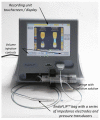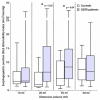Esophagogastric junction distensibility assessed with an endoscopic functional luminal imaging probe (EndoFLIP)
- PMID: 20541755
- PMCID: PMC3019759
- DOI: 10.1016/j.gie.2010.01.069
Esophagogastric junction distensibility assessed with an endoscopic functional luminal imaging probe (EndoFLIP)
Abstract
Background: Increased esophagogastric junction (EGJ) compliance is a key abnormality in GERD leading to increased volumes of reflux. To date, EGJ distensibility has been measured only with investigational barostat-based prototype devices.
Objectives: The aim of the study was to test the endoscopic functional luminal imaging probe (EndoFLIP), a new commercially available technology designed to measure intraluminal distensibility, by assessing the EGJ of GERD patients and controls.
Design: Prospective case-control series.
Setting: Tertiary referral center.
Subjects: Twenty GERD patients and 20 controls studied during a routine esophagogastroduodenoscopy.
Methods: The EndoFLIP was passed through the endoscopic instrumentation channel and positioned across the EGJ. The EndoFLIP uses impedance planimetry to measure 16 cross-sectional areas (CSA) along with the corresponding intrabag pressure within a 4.6-cm cylindrical segment of a fluid-filled bag.
Main outcome measurement: EGJ distensibility was assessed with 10- to 40-mL volume-controlled distentions.
Results: In both groups, the least distensible locus at the EGJ was usually at the hiatus. As a group, GERD patients exhibited two- to threefold increased EGJ distensibility compared with controls, particularly at 20- to 30-mL distention volumes, values quantitatively similar to previous measurements with barostat-based devices. The endoscopic estimation of EGJ distensibility, the flap valve grade, correlated poorly with EndoFLIP measurements.
Limitations: Heterogeneity of GERD patients.
Conclusions: Measurement of EGJ distensibility with EndoFLIP is feasible during clinical endoscopy. Stratifying GERD patients according to this physiological parameter may facilitate the identification of patient subgroups responsive or unresponsive to medical or surgical treatments.
Copyright 2010 American Society for Gastrointestinal Endoscopy. Published by Mosby, Inc. All rights reserved.
Figures





References
-
- Jenkinson AD, Scott SM, Yazaki E, et al. Compliance measurement of lower esophageal sphincter and esophageal body in achalasia and gastroesophageal reflux disease. Dig Dis Sci. 2001;46:1937–42. - PubMed
-
- Pandolfino JE, Shi G, Trueworthy B, et al. Esophagogastric junction opening during relaxation distinguishes nonhernia reflux patients, hernia patients, and normal subjects. Gastroenterology. 2003;125:1018–24. - PubMed
-
- Pandolfino JE, Shi G, Curry J, et al. Esophagogastric junction distensibility: a factor contributing to sphincter incompetence. Am J Physiol Gastrointest Liver Physiol. 2002;282:G1052–8. - PubMed
Publication types
MeSH terms
Grants and funding
LinkOut - more resources
Full Text Sources
Medical
Research Materials

